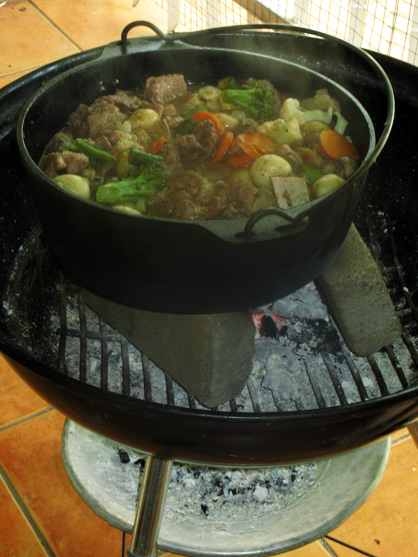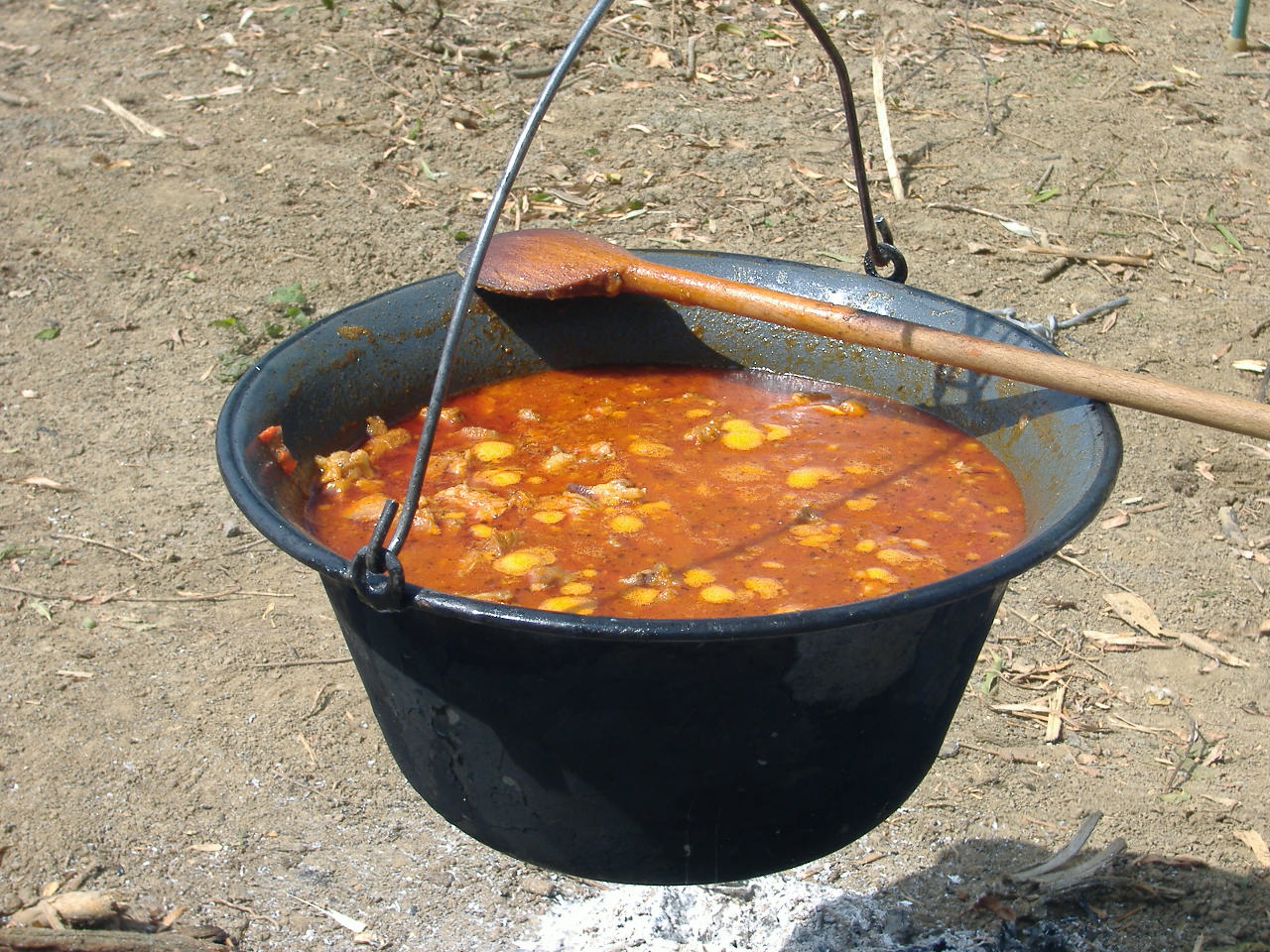|
Potjiekos
In South Africa, a potjiekos , literally translated "small-pot food", is a dish prepared outdoors. It is traditionally cooked in a round, cast iron, three-legged cauldron, the ''potjie'', descended from the Dutch oven brought from the Netherlands to South Africa in the 17th century and found in the homes and villages of people throughout southern Africa. The pot is heated using small amounts of wood or charcoal or, if fuel is scarce, twisted grass or even dried animal dung. History Traditionally, the recipe includes meat, vegetables like carrots, cabbage, cauliflower, or pumpkin, starches like rice or potatoes, all slow-cooked with Dutch- Malay spices, the distinctive spicing of South Africa's early culinary melting pot. Other common ingredients include fruits and flour-based products like pasta. Potjiekos originated with the Voortrekkers, evolving as a stew made of venison and vegetables (if available), cooked in the potjie. As ''trekkers'' (pioneers) shot wild game, it was a ... [...More Info...] [...Related Items...] OR: [Wikipedia] [Google] [Baidu] |
Dutch Oven
A Dutch oven, Dutch pot (US English), or casserole dish (international) is a thick-walled cooking pot with a tight-fitting lid. Dutch ovens are usually made of seasoned cast iron; however, some Dutch ovens are instead made of cast aluminium, or ceramic. Some metal varieties are enameled rather than being seasoned, and these are sometimes called French ovens. The international name casserole dish is from the French which means "cooking pot". They are similar to both the Japanese and the , a traditional Balkan cast-iron oven, and are related to the South African , the Australian Bedourie oven and Spanish . History Early European history During the 17th century, brass was the preferred metal for English cookware and domestic utensils, and the Dutch produced it at the lowest cost, which, however, was still expensive. In 1702, Abraham Darby was a partner in the Brass Works Company of Bristol, which made malt mills for breweries. Apparently in 1704, Darby visited the Netherlands ... [...More Info...] [...Related Items...] OR: [Wikipedia] [Google] [Baidu] |
South Africa
South Africa, officially the Republic of South Africa (RSA), is the Southern Africa, southernmost country in Africa. Its Provinces of South Africa, nine provinces are bounded to the south by of coastline that stretches along the Atlantic Ocean, South Atlantic and Indian Ocean; to the north by the neighbouring countries of Namibia, Botswana, and Zimbabwe; to the east and northeast by Mozambique and Eswatini; and it encloses Lesotho. Covering an area of , the country has Demographics of South Africa, a population of over 64 million people. Pretoria is the administrative capital, while Cape Town, as the seat of Parliament of South Africa, Parliament, is the legislative capital, and Bloemfontein is regarded as the judicial capital. The largest, most populous city is Johannesburg, followed by Cape Town and Durban. Cradle of Humankind, Archaeological findings suggest that various hominid species existed in South Africa about 2.5 million years ago, and modern humans inhabited the ... [...More Info...] [...Related Items...] OR: [Wikipedia] [Google] [Baidu] |
Cauldron
A cauldron (or caldron) is a large cookware and bakeware, pot (kettle) for cooking or boiling over an open fire, with a lid and frequently with an arc-shaped hanger and/or integral handles or feet. There is a rich history of cauldron lore in religion, mythology, and folklore. Etymology The word cauldron is first recorded in Middle English as ''caudroun'' (13th century). It was borrowed from Norman language, Norman ''caudron''T. F. Hoad, ''English Etymology'', Oxford University Press, 1993 (). p. 67. (Picard language, Picard ''caudron'', ). It represents the phonetical evolution of Vulgar Latin ''*caldario'' for Classical Latin ''caldārium'' "hot bath", that derives from ''cal(i)dus'' "hot". The Norman-French word replaces the Old English ''ċetel'' (German ''(Koch)Kessel'' "cauldron", Dutch ''(kook)ketel'' "cauldron"), Middle English ''chetel''. The word "kettle" is a borrowing of the Old Norse variant ''ketill'' "cauldron". History From Latin origin, the term cauldron i ... [...More Info...] [...Related Items...] OR: [Wikipedia] [Google] [Baidu] |
Stew
A stew is a combination of solid food ingredients that have been Cooking, cooked in Soup, liquid and served in the resultant gravy. Ingredients can include any combination of vegetables and may include meat, especially tougher meats suitable for slow-cooking, such as beef, pork, venison, Rabbit as food, rabbit, lamb and mutton, lamb, poultry, sausages, and seafood. While water can be used as the stew-cooking liquid, Stock (food), stock is also common. A small amount of red wine or other alcohol is sometimes added for flavour. Seasonings and flavourings may also be added. Stews are typically cooked at a relatively low temperature (Simmering, simmered, not Boiling, boiled), allowing flavours to mingle. Stewing is suitable for the least tender cuts of meat that become tender and juicy with the slow, moist heat method. This makes it popular for low-cost cooking. Cuts with a certain amount of marbling and gelatinous connective tissue give moist, juicy stews, while lean meat may easily ... [...More Info...] [...Related Items...] OR: [Wikipedia] [Google] [Baidu] |
Bushpig
:''"Bush pig" may also refer to the red river hog.'' The bushpig (''Potamochoerus larvatus'') is a member of the pig family that inhabits forests, woodland, riverine vegetation and cultivated areas in East and Southern Africa. Probably introduced populations are also present in Madagascar. There have also been unverified reports of their presence on the Comoro island of Mayotte. Bushpigs are mainly nocturnal. There are several subspecies. The vernacular name 'bushpig' may be used for either '' Potamochoerus'' species. Description Adult bushpigs stand from at the shoulder, and mature boars can reach a weight of , although is more common. Sows are . They resemble the domestic pig, and can be identified by their pointed, tufted ears and face mask. Bushpigs vary in hair colour and skin colour over their range, southern ''koiropotamus'' and ''nyasae'' populations are dark reddish, sometimes almost black. The coat colour darkens with age. Their heads have a 'face mask' with a ... [...More Info...] [...Related Items...] OR: [Wikipedia] [Google] [Baidu] |
Warthog
''Phacochoerus'' is a genus in the family Suidae, commonly known as warthogs (pronounced ''wart-hog''). They are pigs who live in open and semi-open habitats, even in quite arid regions, in sub-Saharan Africa. The two species were formerly considered conspecific under the scientific name ''Phacochoerus aethiopicus'', but today this is limited to the desert warthog, while the best-known and most widespread species, the common warthog (or simply warthog), is ''Phacochoerus africanus''. Description left, Skull Although covered in bristly hairs, a warthog's body and head appear largely bare, from a distance, with only a crest of hair along the back and the tufts on the face and tail being obvious. The English name "wart"-hog refers to their facial wattles, which are particularly distinct in males. The males also have very prominent tusks, which reach a length of ; females' tusks are always smaller.Novak, R. M. (editor) (1999). ''Walker's Mammals of the World.'' Vol. 2. 6th editio ... [...More Info...] [...Related Items...] OR: [Wikipedia] [Google] [Baidu] |
Guinea Fowl
Guinea fowl () (or guineahen) are birds of the family Numididae in the order Galliformes. They are endemic to Africa and rank among the oldest of the gallinaceous birds. Phylogenetics, Phylogenetically, they branched off from the core Galliformes after the Cracidae (chachalacas, guans, and curassows) and before the Odontophoridae (New World quail). An Eocene fossil lineage ''Telecrex'' has been associated with guinea fowl; ''Telecrex'' inhabited Mongolia, and may have given rise to the oldest of the true Phasianidae, phasianids, such as blood pheasants and Crossoptilon, eared pheasants, which Evolution, evolved into high-altitude, montane-adapted species with the rise of the Tibetan Plateau. While modern guinea fowl species are endemic to Africa, the helmeted guinea fowl has been Introduced species, introduced as a domesticated bird widely elsewhere. Taxonomy and systematics This is a list of guinea fowl species, presented in taxonomic order. Phylogeny Cladogram based on a s ... [...More Info...] [...Related Items...] OR: [Wikipedia] [Google] [Baidu] |
Rice
Rice is a cereal grain and in its Domestication, domesticated form is the staple food of over half of the world's population, particularly in Asia and Africa. Rice is the seed of the grass species ''Oryza sativa'' (Asian rice)—or, much less commonly, ''Oryza glaberrima'' (African rice). Asian rice was domesticated in China some 13,500 to 8,200 years ago; African rice was domesticated in Africa about 3,000 years ago. Rice has become commonplace in many cultures worldwide; in 2023, 800 million tons were produced, placing it third after sugarcane and maize. Only some 8% of rice is traded internationally. China, India, and Indonesia are the largest consumers of rice. A substantial amount of the rice produced in developing nations is lost after harvest through factors such as poor transport and storage. Rice yields can be reduced by pests including insects, rodents, and birds, as well as by weeds, and by List of rice diseases, diseases such as rice blast. Traditional rice polyc ... [...More Info...] [...Related Items...] OR: [Wikipedia] [Google] [Baidu] |
Wagon
A wagon (or waggon) is a heavy four-wheeled vehicle pulled by Working animal#Draft animals, draft animals or on occasion by humans, used for transporting goods, commodities, agricultural materials, supplies and sometimes people. Wagons are immediately distinguished from carts (which have two wheels) and from lighter four-wheeled vehicles primarily for carrying people, such as carriages. Common animals which pull wagons are horses, mules, and oxen. One animal or several, often in pairs or teams may pull wagons. However, there are examples of human-propelled wagons, such as Corf (mining), mining corfs. A wagon was formerly called a wain and one who builds or repairs wagons is a Wainwright (occupation), wainwright. More specifically, a wain is a type of horse- or oxen-drawn, load-carrying vehicle, used for agricultural purposes rather than transporting people. A wagon or cart, usually four-wheeled; for example, a haywain, normally has four wheels, but the term has now acquired s ... [...More Info...] [...Related Items...] OR: [Wikipedia] [Google] [Baidu] |
Venison
Venison refers primarily to the meat of deer (or antelope in South Africa). Venison can be used to refer to any part of the animal, so long as it is edible, including the internal organs. Venison, much like beef or pork, is categorized into specific primal cut, cuts, including roasting, roast, sirloin steak, sirloin, and ribs (food), ribs. Etymology The word derives from the Latin , meaning . This term entered the English language through Norman French in the 11th century, following the Norman Conquest of England and the establishment of Royal Forests. Definition ''Venison'' originally described any meat obtained through the process of hunting a wild game animal. It was applied to any animal from the family (biology), families Cervidae (true deer), Leporidae (rabbits and hares), Suidae (wild boar) and certain species of the genus ''Capra (genus), Capra'' (goats and ibex). In Southern Africa, the word ''venison'' refers to the meat of antelope, a Bovidae taxon, as there are n ... [...More Info...] [...Related Items...] OR: [Wikipedia] [Google] [Baidu] |
Rabbit
Rabbits are small mammals in the family Leporidae (which also includes the hares), which is in the order Lagomorpha (which also includes pikas). They are familiar throughout the world as a small herbivore, a prey animal, a domesticated form of livestock, and a pet, having a widespread effect on ecologies and cultures. The most widespread rabbit genera are '' Oryctolagus'' and '' Sylvilagus''. The former, ''Oryctolagus'', includes the European rabbit, ''Oryctolagus cuniculus'', which is the ancestor of the hundreds of breeds of domestic rabbit and has been introduced on every continent except Antarctica. The latter, ''Sylvilagus'', includes over 13 wild rabbit species, among them the cottontails and tapetis. Wild rabbits not included in ''Oryctolagus'' and ''Sylvilagus'' include several species of limited distribution, including the pygmy rabbit, volcano rabbit, and Sumatran striped rabbit. Rabbits are a paraphyletic grouping, and do not constitute a clade, as ha ... [...More Info...] [...Related Items...] OR: [Wikipedia] [Google] [Baidu] |







